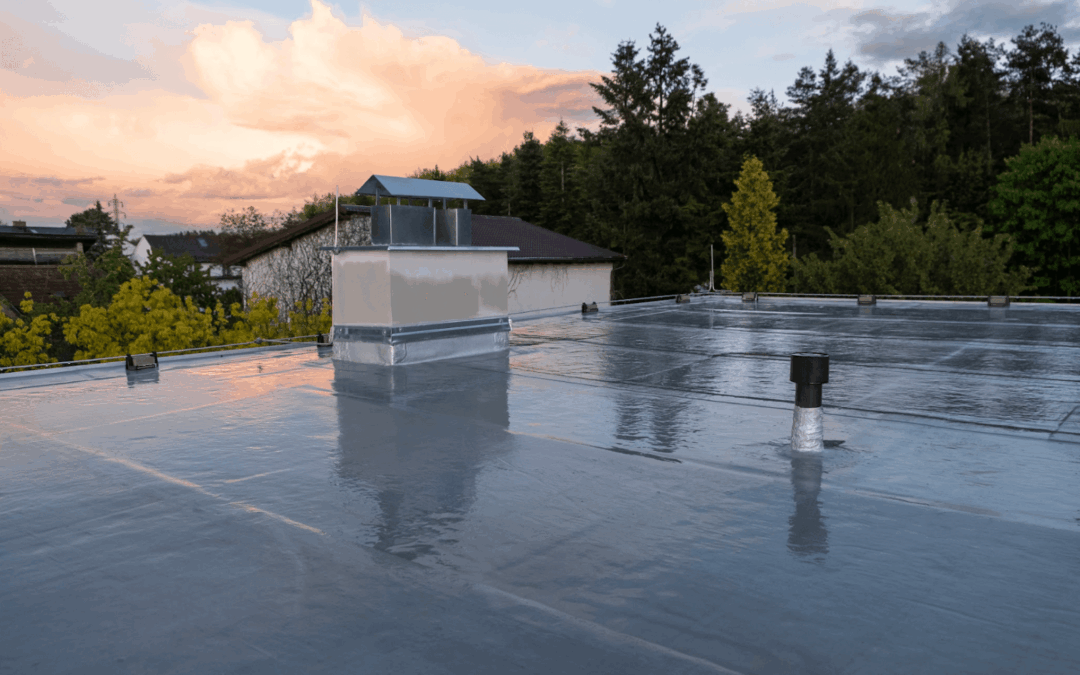Living or working in the Colorado mountains means enjoying epic views, fresh powder, and crisp alpine air, but it also means dealing with serious snow accumulation, especially on your roof. Snow load isn’t just a seasonal inconvenience for property owners with flat or low-slope roofing needs. It’s a structural concern that can lead to leaks, damage, or even collapse if not addressed properly.
Whether you manage a commercial facility in Winter Park or own a mountain home in Fraser, it’s critical to prepare your flat roof for winter long before the first storm rolls in. In this guide, we’ll walk you through the key steps to keep your roof safe, sound, and snow-ready.
Why Flat Roofs Are Especially Vulnerable to Snow Load
Unlike pitched roofs that naturally shed snow as it accumulates, flat roofs allow snow to sit and build up, sometimes for weeks or months at a time. This sustained weight can:
- Exceed your roof’s load-bearing limits
- Compromise waterproofing membranes
- Cause sagging or structural stress
- Lead to ponding water when snow melts and refreezes
- Trigger internal leaks and insulation failure
Proper snow load preparation isn’t optional in areas like Grand County, Colorado, where snowfall averages 200+ inches per year. It’s essential for protecting your property and everyone inside it.
Step 1: Schedule a Pre-Winter Roof Inspection
The best way to start the snow season is with a professional flat roof inspection. A licensed roofer can spot signs of wear or damage that could become serious once snow starts piling up.
What we look for during a winter prep inspection:
- Cracked or aging membranes
- Weak seams or loose flashing
- Pooling water or soft spots
- Drainage issues or clogs
- Structural concerns such as sagging or uneven sections
At Integrity Pro Roofing, we offer complimentary digital roof analysis and reporting, so you know exactly what condition your roof is in and what needs to be addressed before the snow flies.
Step 2: Clear Debris from the Roof Surface
Leaves, twigs, and dirt may not seem like a big deal, but once snow covers them, they can block drains, trap moisture, and promote ice dam formation.
Before the first storm, be sure to:
- Remove all debris from the roof surface
- Clear around vents, pipes, and HVAC units
- Check that ballast or gravel is evenly distributed (for built-up roofs)
If you’re not sure whether it’s safe to walk on your roof, let a pro handle it. Improper access can damage membranes or lead to personal injury.
Step 3: Inspect and Clean the Drainage System
Proper drainage is critical for flat roofs in winter. When snow begins to melt, especially during brief warmups between storms, water needs a clear path to exit the roof. If drains, scuppers, or gutters are blocked, you risk water backing up under the membrane or refreezing into damaging ice dams.
Pre-winter drainage checklist:
- Remove all debris from internal drains and scuppers
- Ensure downspouts are clear and directed away from the building
- Check for signs of corrosion, leaks, or disconnected drain pipes
- Consider adding heat cables to prevent freezing in key areas
If your roof has chronic ponding issues, you may need to explore long-term drainage improvements or a protective coating system to help prevent water infiltration.
Step 4: Assess Structural Load Capacity
Most modern commercial and residential roofs in Colorado are designed to handle up to 30–60 pounds per square foot of snow load, depending on local codes. However, older buildings or those that have experienced previous roof issues may be at risk.
Signs your flat roof may be struggling under snow weight:
- Visible sagging or bowing in the roofline
- Cracking sounds during snow accumulation
- Difficulty opening doors or windows (from shifting structure)
- Ceiling leaks or sudden interior staining
If you notice these red flags, contact a professional immediately. Structural reinforcement may be necessary before the next major storm.
Step 5: Plan for Safe Snow Removal
Once the snow starts falling, it’s important to monitor accumulation and remove excess weight as needed. But flat roof snow removal requires care. Removing too much, using the wrong tools, or walking on icy surfaces can cause more harm than good.
Flat roof snow removal tips:
- Only remove snow when accumulation exceeds 6–12 inches, or per your building’s engineering guidelines
- Use plastic roof rakes or pushers. Never use metal tools that can puncture the membrane
- Avoid creating snow piles near roof edges or drains
- If unsure or unsafe, hire a professional crew familiar with commercial and flat roof systems
At Integrity Pro Roofing, we work with trusted snow removal partners to offer this service safely to our clients.
Step 6: Watch for Ice Dams and Freeze-Thaw Damage
In Colorado’s mountain climate, temperature swings are common, even in winter. That means snow often melts during the day and refreezes at night, creating ice dams along roof edges and parapets. These block water from draining properly and increase the risk of leaks.
What to watch for:
- Large icicles or ice ridges forming on the roof
- Water stains along upper interior walls
- Pooling water that reappears after every snow event
Solutions include improved drainage, insulation upgrades, or the installation of heat cables in problem areas.
Step 7: Have a Response Plan in Place
Even with the best preparation, unexpected issues can arise during the winter months. Having a roofing emergency plan in place can reduce downtime, property damage, and safety risks.
Your winter roofing response plan should include:
- Contact info for a trusted local roofer (like Integrity Pro Roofing)
- Records of past roof maintenance and warranties
- Clear internal communication protocols for reporting leaks or ceiling damage
- A snow monitoring checklist for property managers or staff
When issues arise, a fast and informed response is the best way to limit impact.
Trust Integrity Pro Roofing for Flat Roof Winter Prep in Colorado
From commercial facilities in Winter Park to residential flat roofs in Grand Lake, Integrity Pro Roofing helps property owners prepare, protect, and perform through every season. Our team specializes in flat and flat metal roofing systems designed for Colorado’s extreme snow loads, UV exposure, and freeze-thaw cycles.
When winter hits, your roof should be ready. Let’s make sure it is. Schedule your free roof estimate today and get ahead of the winter.






